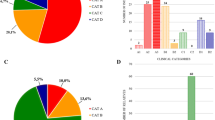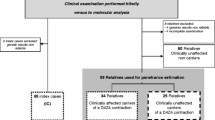Abstract
Facioscapulohumeral muscular dystrophy (FSHD), is a dominantly inherited, late onset, progressive disease. At present, no treatment or prevention of symptoms are available. There is considerable clinical variability, even within families. The gene whose defect causes FSHD has not been identified, but molecular diagnosis can be made by analyzing D4Z4 repeat length on chromosome 4q35. The results can support or rule out the clinical diagnosis of FSHD, but there are also “gray zone”, non-conclusive results. During the years 2000–6, 66 individuals (including 7 asymptomatic individuals), were tested in our institute for D4Z4 repeat number. In 77% of the cases the results were conclusive: two thirds of them supported a diagnosis of FSHD while in a third this diagnosis was ruled out. In 23% the results were in the gray zone. Cognitive involvement was rare, occurring only when the D4Z4 repeat size was very small (<15 kb). Maximal utilization of the existing molecular test for FSHD demands detailed clinical and family pedigree information. We recommend that comprehensive genetic counseling always be given before and after molecular testing for FSHD, in addition to the neurological follow-up. Presymptomatic testing should only be offered when complete molecular evaluation can be offered, including 4qA and 4qB variant analysis.


Similar content being viewed by others
References
Arahata, K., Ishihara, T., Fukunaga, H., Orimo, S., Lee, J. H., Goto, K., et al. (1995). Inflammatory response in facioscapulohumeral muscular dystrophy (FSHD): immunocytochemical and genetic analyses. Muscle & Nerve, 2, S56–S66.
Bakker, E., Van der Wielen, M. J. R., Voorhoeve, E., Ippel, P. F., Padberg, G. W., Frants, R. R., et al. (1996). Diagnostic, predictive, and prenatal testing for facioscapulohumeral muscular dystrophy: diagnostic approach for sporadic and familial cases. Journal of Medical Genetics, 33, 29–35.
Bird, T. D. (1999). Risks and benefits of DNA testing for neurogenetic disorders. Seminars in Neurology, 19, 253–259.
Brouwer, O. F., Padberg, G. W., Bakker, E., Wijmenga, C., & Frants, R. R. (1995). Early onset facioscapulohumeral muscular dystrophy. Muscle & Nerve, 2, S67–S72.
Butz, M., Koch, M. C., Müller-Felber, W., Lemmers, R. J., van der Maarel, S. M., & Schreiber, H. (2003). Facioscapulohumeral muscular dystrophy. Phenotype-genotype correlation in patients with borderline D4Z4 repeat numbers. Journal of Neurology, 250(8), 932–937.
Dorobek, M., & Kabzińska, D. (2004). A severe case of facioscapulohumeral muscular dystrophy (FSHD) with some uncommon clinical features and a short 4q35 fragment. European Journal of Paediatric Neurology, 8(6), 313–316.
Flanigan, K. M., Coffeen, C. M., Sexton, L., Stauffer, D., Brunner, S., & Leppert, M. F. (2001). Genetic characterization of a large, historically significant Utah kindred with facioscapulohumeral dystrophy. Neuromuscular Disorders, 11(6–7), 525–529.
Funakoshi, M., Goto, K., & Arahata, K. (1998). Epilepsy and mental retardation in a subset of early onset 4q35-facioscapulohumeral muscular dystrophy. Neurology, 50(6), 1791–1794.
Harper, J. C., Delhanty, J. D., & Handyside, A. H. (2001). Preimplantation genetic diagnosis. West Sussex: John Wiley and Sons.
Kakourou, G., Dhanjal, S., Mamas, T., Gotts, S., Doshi, A., Fordham, K., et al. (2008). Preimplantation genetic diagnosis for myotonic dystrophy type 1 in the UK. Neuromuscular Disorders, 18(2), 131–136.
Kissel, J. T. (1999). Facioscapulohumeral dystrophy. Seminars in Neurology, 19(1), 35–43.
Klinge, L., Eagle, M., Haggerty, I. D., Roberts, C. E., Straub, V., & Bushby, K. M. (2006). Severe phenotype in infantile facioscapulohumeral muscular dystrophy. Neuromuscular Disorders, 16(9–10), 553–558.
Krasnianski, M., Neudecker, S., Eger, K., Jakubiczka, S., & Zierz, S. (2003). Typical facioscapulohumeral dystrophy phenotype in patients without FSHD 4q35 deletion. Journal of Neurology, 250(9), 1084–1087.
Lemmers, R. J., Osborn, M., Haaf, T., Rogers, M., Frants, R. R., Padberg, G. W., et al. (2003). D4F104S1 deletion in facioscapulohumeral muscular dystrophy: phenotype, size, and detection. Neurology, 61(2), 178–183.
Lemmers, R. J., van der Wielen, M. J., Bakker, E., Padberg, G. W., Frants, R. R., & van der Maarel, S. M. (2004). Somatic mosaicism in FSHD often goes undetected. Annals of Neurology, 55(6), 845–850.
Lemmers, R. J., Wohlgemuth, M., van der Gaag, K. J., van der Vliet, P. J., van Teijlingen, C. M., de Knijff, P., et al. (2007). Specific sequence variations within the 4q35 region are associated with facioscapulohumeral muscular dystrophy. American Journal of Human Genetics, 81(5), 884–894.
Lunt, P. W., & Harper, P. S. (1991). Genetic counselling in facioscapulohumeral muscular dystrophy. Journal of Medical Genetics, 28(10), 655–664.
Malcov, M., Ben-Yosef, D., Schwartz, T., Mey-Raz, N., Azem, F., Lessing, J. B., et al. (2005). Preimplantation genetic diagnosis (PGD) for Duchenne muscular dystrophy (DMD) by triplex-nested PCR. Prenatal Diagnosis, 25(13), 1200–1205.
Miura, K., Kumagai, T., Matsumoto, A., Iriyama, E., Watanabe, K., Goto, K., et al. (1998). Two cases of chromosome 4q35-linked early onset facioscapulohumeral muscular dystrophy with mental retardation and epilepsy. Neuropediatrics, 29(5), 239–241.
Podnar, S., & Zidar, J. (2006). Sensitivity of motor unit potential analysis in facioscapulohumeral muscular dystrophy. Muscle & Nerve, 34(4), 451–456.
Sacconi, S., Salviati, L., Bourget, I., Figarella, D., Péréon, Y., Lemmers, R., et al. (2006). Diagnostic challenges in facioscapulohumeral muscular dystrophy. Neurology, 24;67(8), 1464–1466.
Saito, Y., Miyashita, S., Yokoyama, A., Komaki, H., Seki, A., Maegaki, Y., et al. (2007). Facioscapulohumeral muscular dystrophy with severe mental retardation and epilepsy. Brain & Development, 29(4), 231–233.
Smith, C. O., Lipe, H. P., & Bird, T. D. (2004). Impact of presymptomatic genetic testing for hereditary ataxia and neuromuscular disorders. Archives of Neurology, 61(6), 875–880.
Tawil, R., & Van Der Maarel, S. M. (2006). Facioscapulohumeral muscular dystrophy. Muscle & Nerve, 34(1), 1–15.
Tawil, R., Forrester, J., Griggs, R. C., Mendell, J., Kissel, J., McDermott, M., et al. (1996). Evidence for anticipation and association of deletion size with severity infacioscapulohumeral muscular dystrophy. The FSH-DY Group. Annals of Neurology, 39(6), 744–748.
Tawil, R., Figlewicz, D. A., Griggs, R. C., & Weiffenbach, B. (1998). Facioscapulohumeral dystrophy: a distinct regional myopathy with a novel molecular pathogenesis. FSH Consortium. Ann Neurol, 43, 279–282.
Thomas, N. S., Wiseman, K., Spurlock, G., MacDonald, M., Ustek, D., & Upadhyaya, M. (2007). A large patient study confirming that facioscapulohumeral muscular dystrophy (FSHD) disease expression is almost exclusively associated with an FSHD locus located on a 4qA-defined 4qter subtelomere. Journal of Medical Genetics, 44(3), 215–218.
Tonini, M. M., Passos-Bueno, M. R., Cerqueira, A., Matioli, S. R., Pavanello, R., & Zatz, M. (2004). Asymptomatic carriers and gender differences in facioscapulohumeral muscular dystrophy (FSHD). Neuromuscular Disorders, 4(1), 33–38.
Trevisan, C. P., Pastorello, E., Ermani, M., Angelini, C., Tomelleri, G., Tonin, P., et al. (2008). Facioscapulohumeral muscular dystrophy: a multicenter study on hearing function. Audiology & Neuro-Otology, 13(1), 1–6.
Upadhyaya, M., MacDonald, M., & Ravine, D. (1999). Prenatal diagnosis for facioscapulohumeral muscular dystrophy (FSHD). Prenatal Diagnosis, 19(10), 959–965.
Wijmenga, C., Frants, R. R., Brouwer, O. F., Moerer, P., Weber, J. L., & Padberg, G. W. (1990). Location of facioscapulohumeral muscular dystrophy gene on chromosome 4. Lancet, 15;336(8716), 651–653.
Wijmenga, C., Frants, R. R., Hewitt, J. E., van Deutekom, J. C., van Geel, M., Wright, T. J., et al. (1993). Molecular genetics of facioscapulohumeral muscular dystrophy. Neuromuscular Disorders, 3(5–6), 487–491.
Wu, Z. Y., Wang, Z. Q., Murong, S. X., & Wang, N. (2004). FSHD in Chinese population: characteristics of translocation and genotype-phenotype correlation. Neurology, 63(3), 581–583.
Zatz, M., Marie, S. K., Passos-Bueno, M. R., Vainzof, M., Campiotto, S., Cerqueira, A., et al. (1995). High proportion of new mutations and possible anticipation in Brazilian facioscapulohumeral muscular dystrophy families. American Journal of Human Genetics, 56(1), 99–105.
Zatz, M., Marie, S. K., Cerqueira, A., Vainzof, M., Pavanello, R. C., & Passos-Bueno, M. R. (1998). The facioscapulohumeral muscular dystrophy (FSHD1) gene affects males more severely and more frequently than females. Am J Med Genet, 1;77(2), 155–161.
Author information
Authors and Affiliations
Corresponding author
Rights and permissions
About this article
Cite this article
Yanoov-Sharav, M., Leshinsky-Silver, E., Cohen, S. et al. Genetic Counseling and Testing for FSHD (Facioscapulohumeral Muscular Dystrophy) in the Israeli Population. J Genet Counsel 21, 557–563 (2012). https://doi.org/10.1007/s10897-011-9422-5
Received:
Accepted:
Published:
Issue Date:
DOI: https://doi.org/10.1007/s10897-011-9422-5




